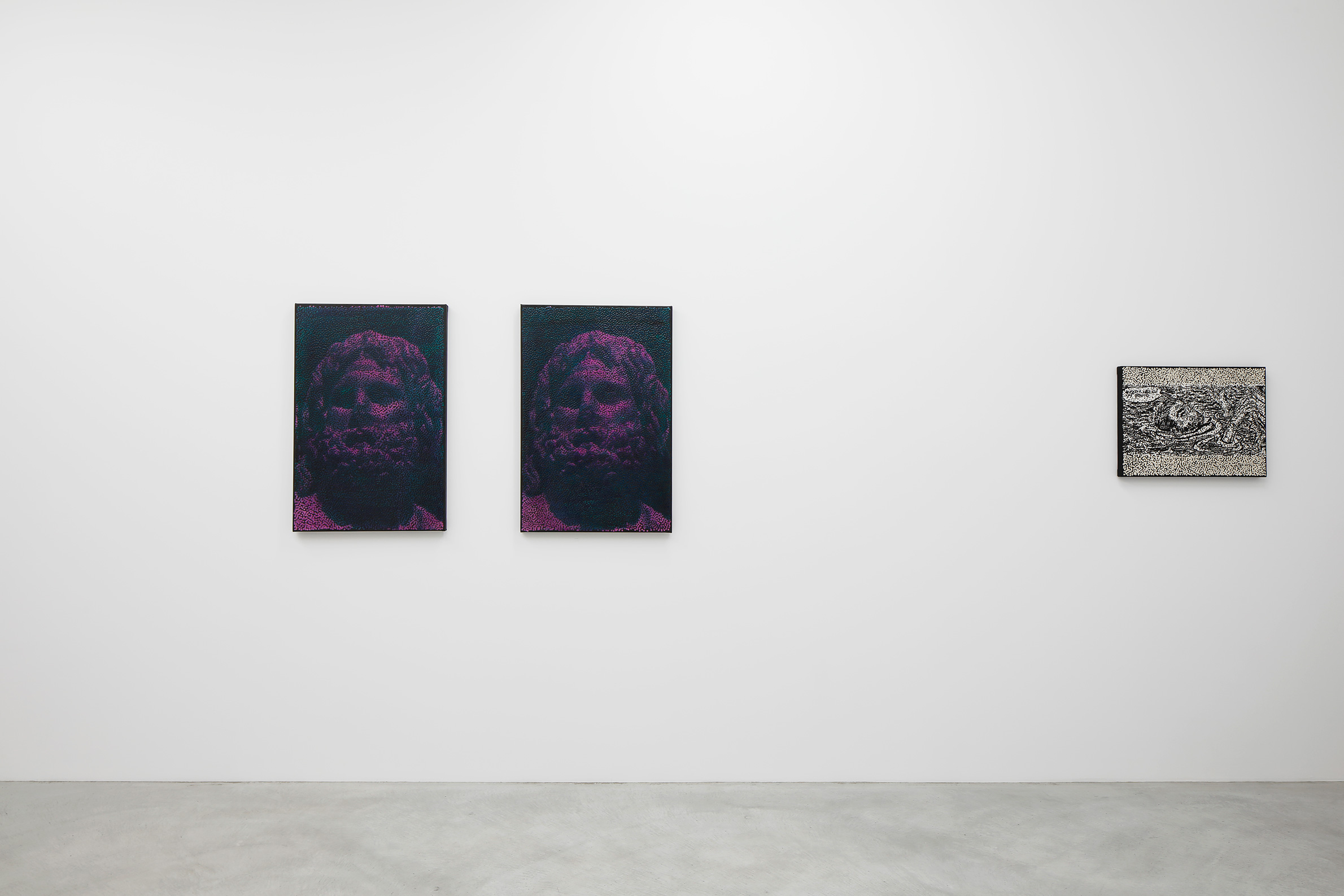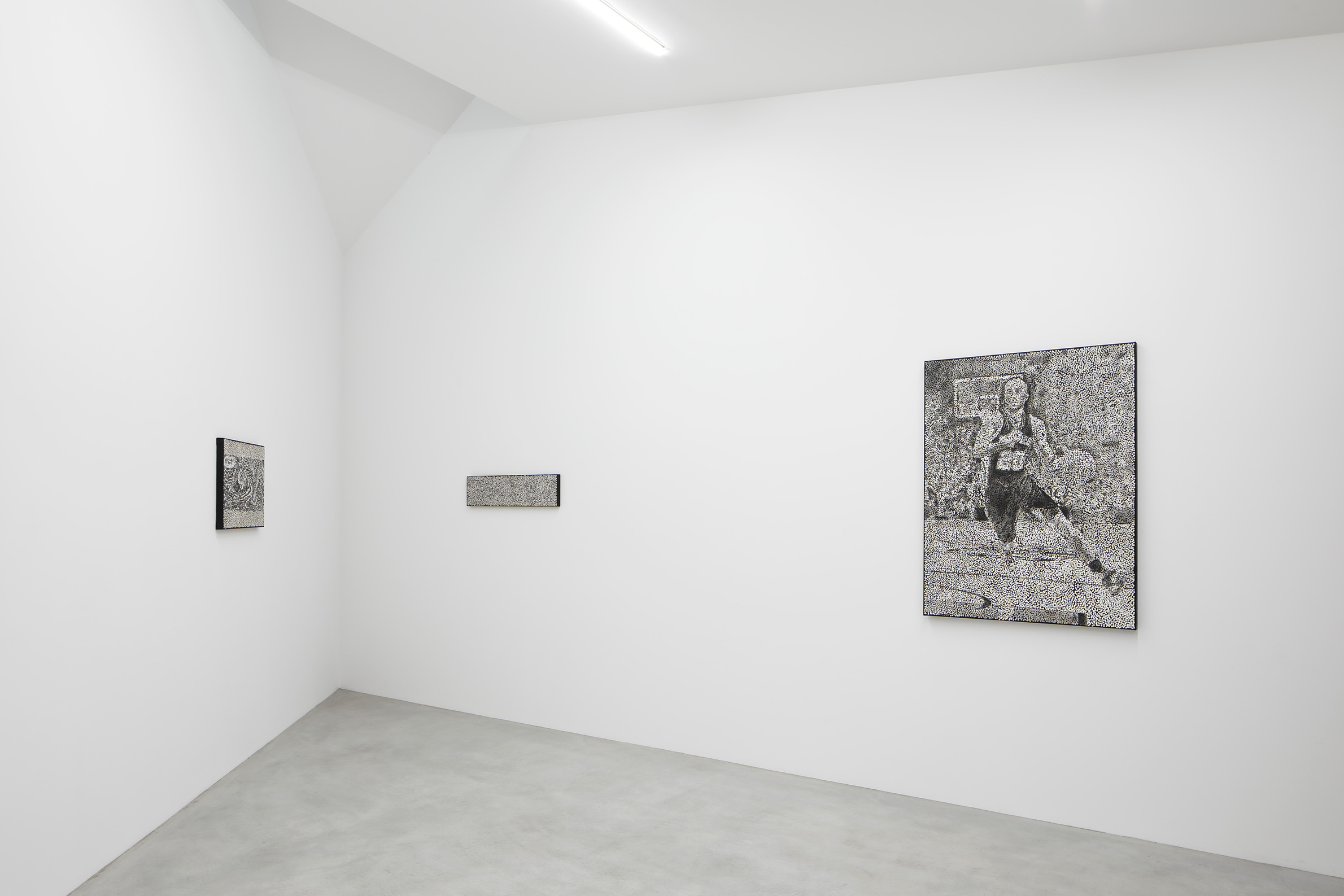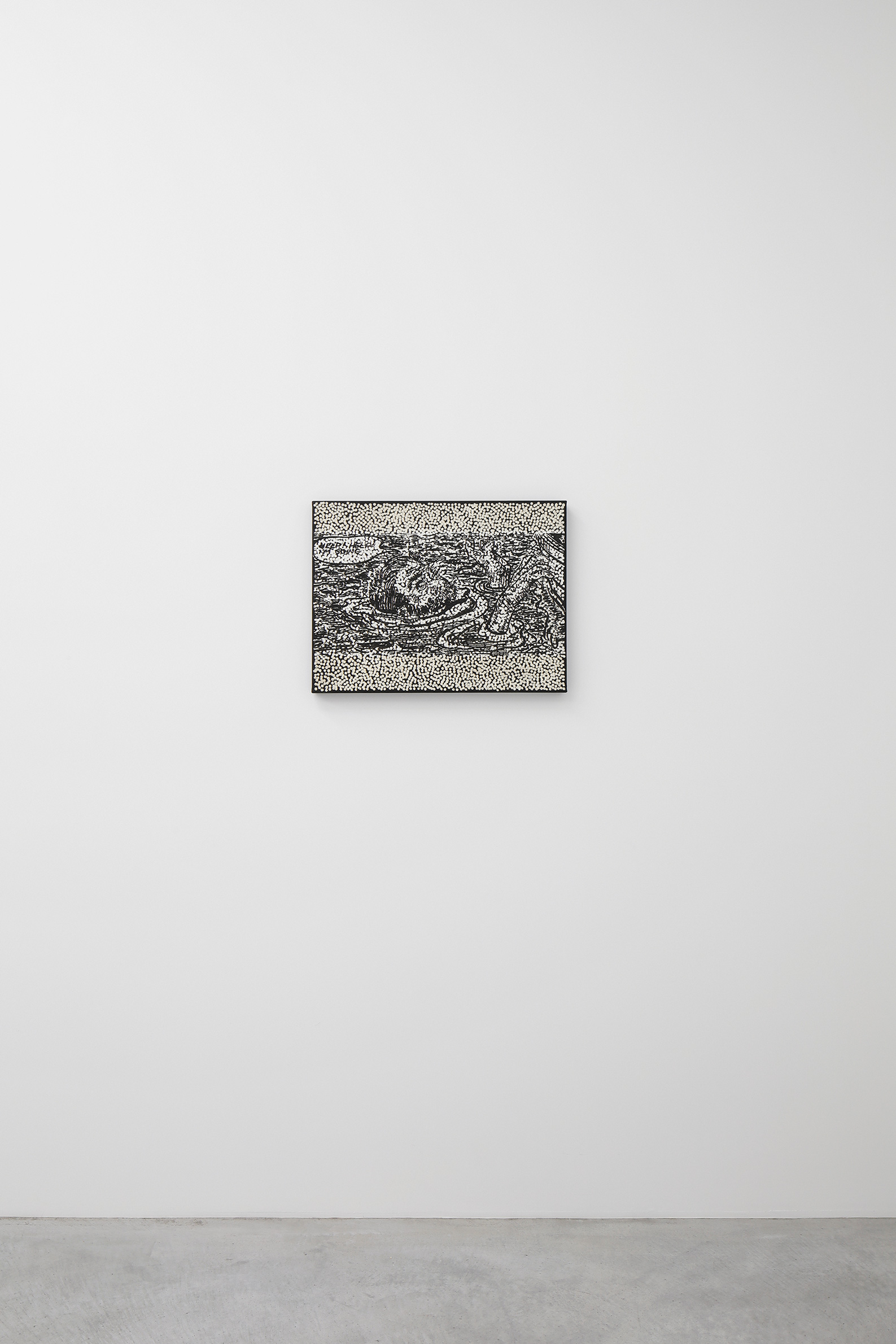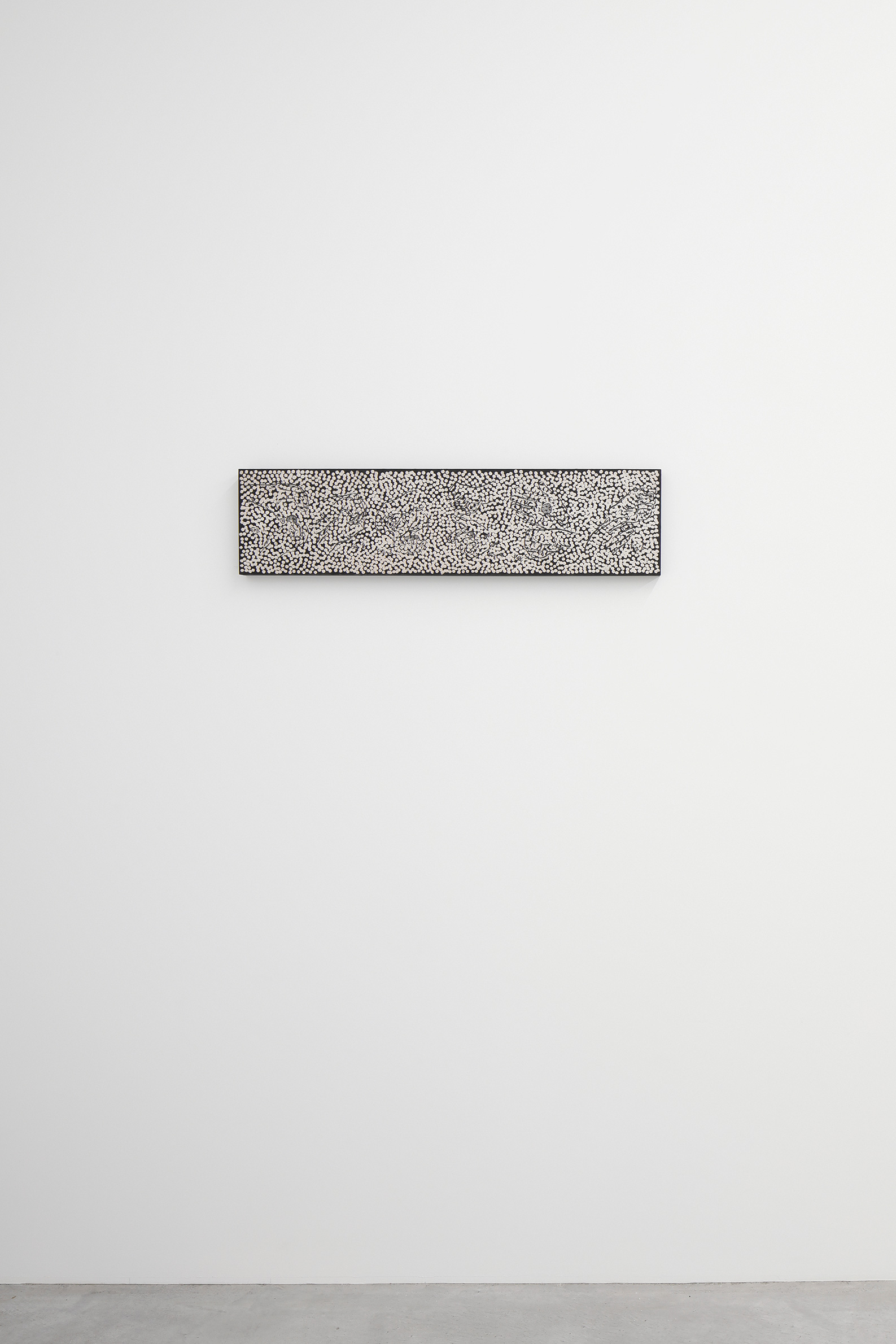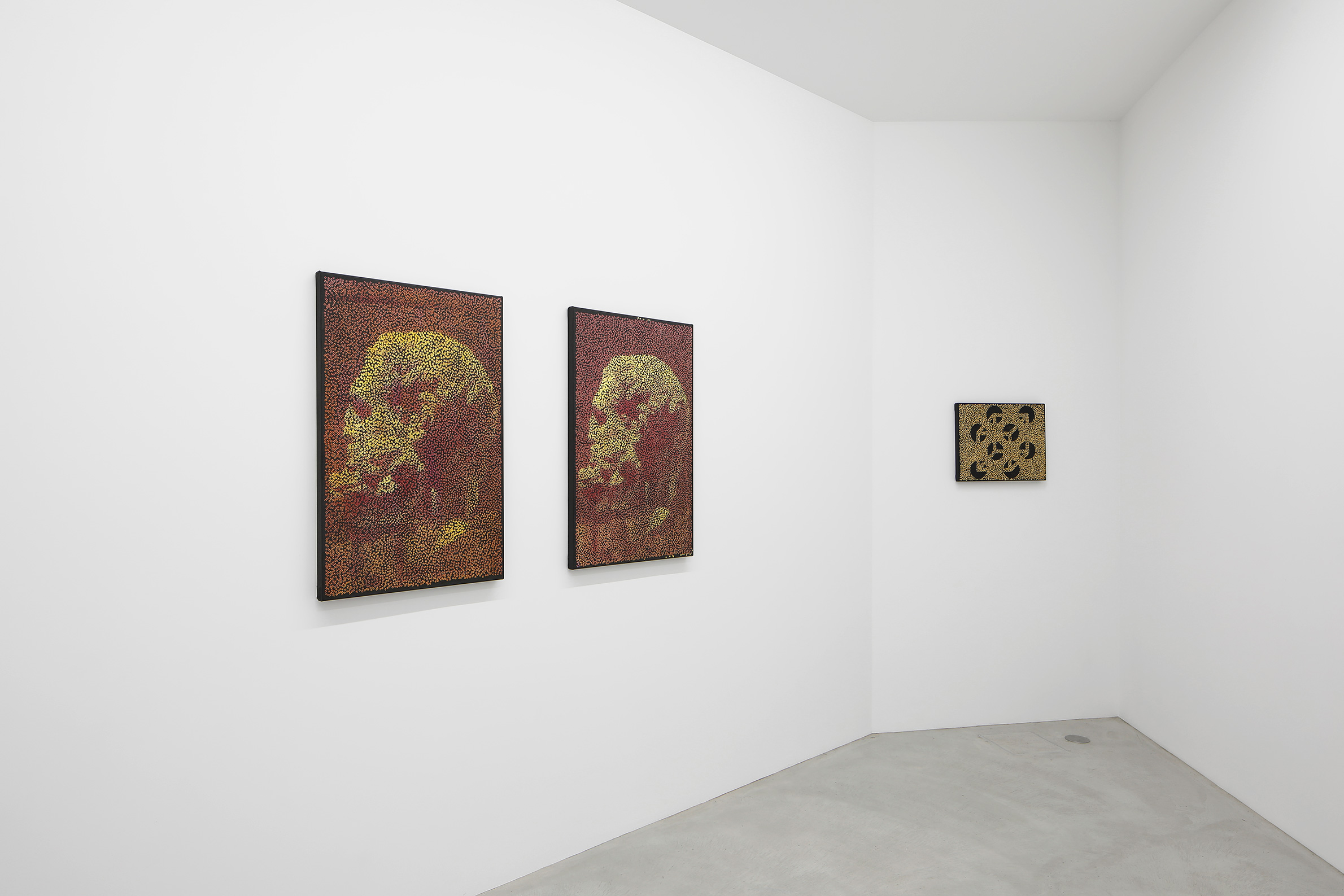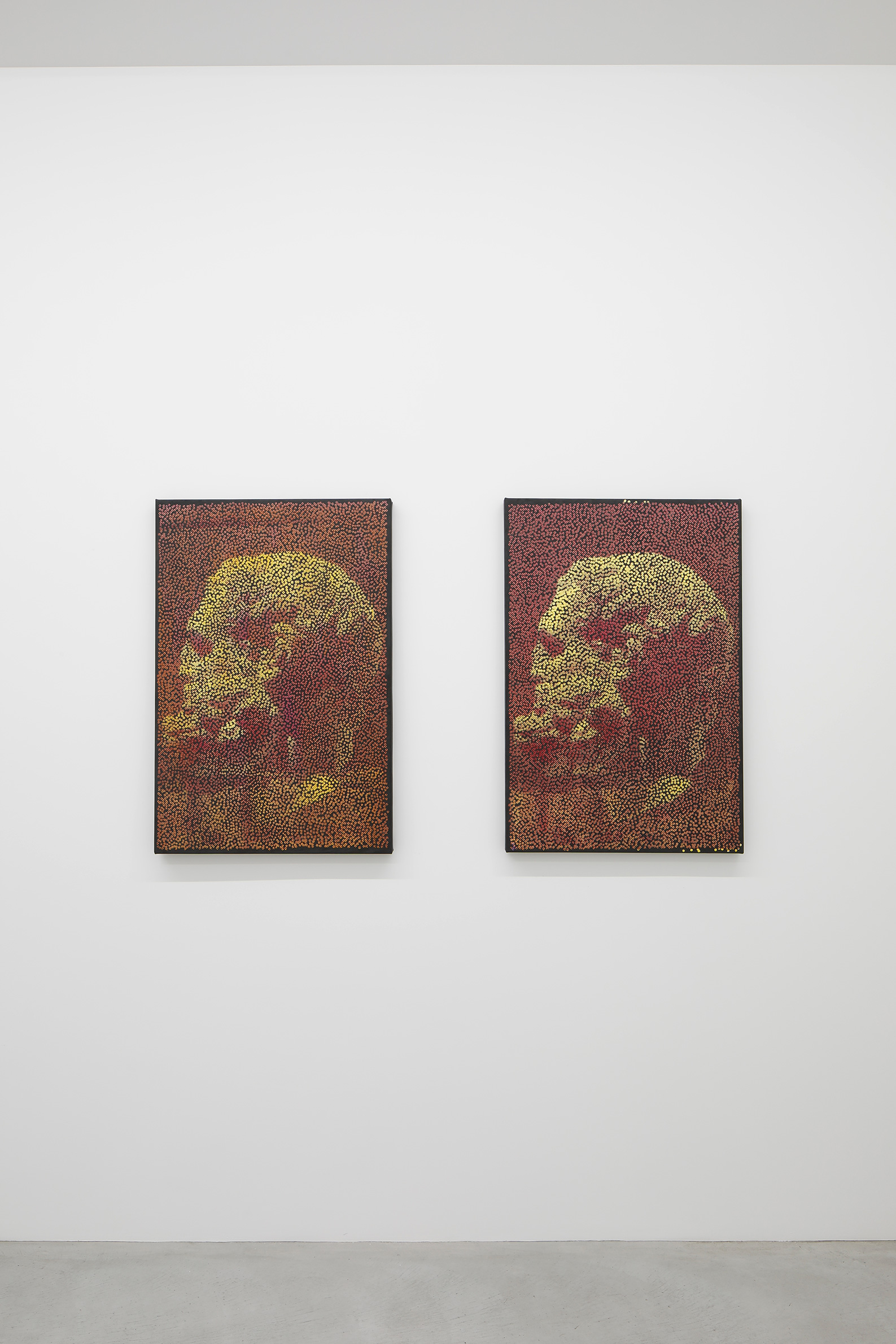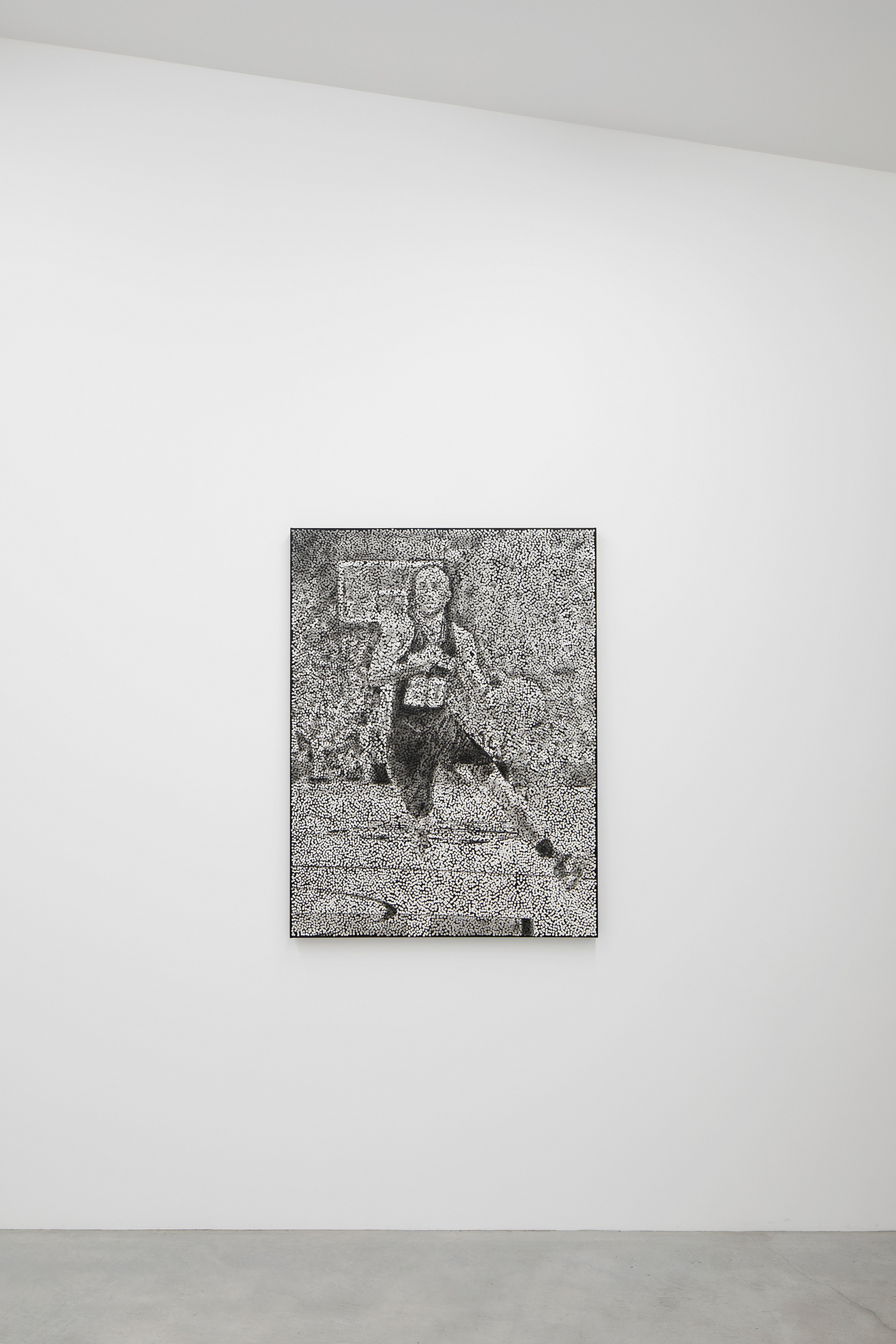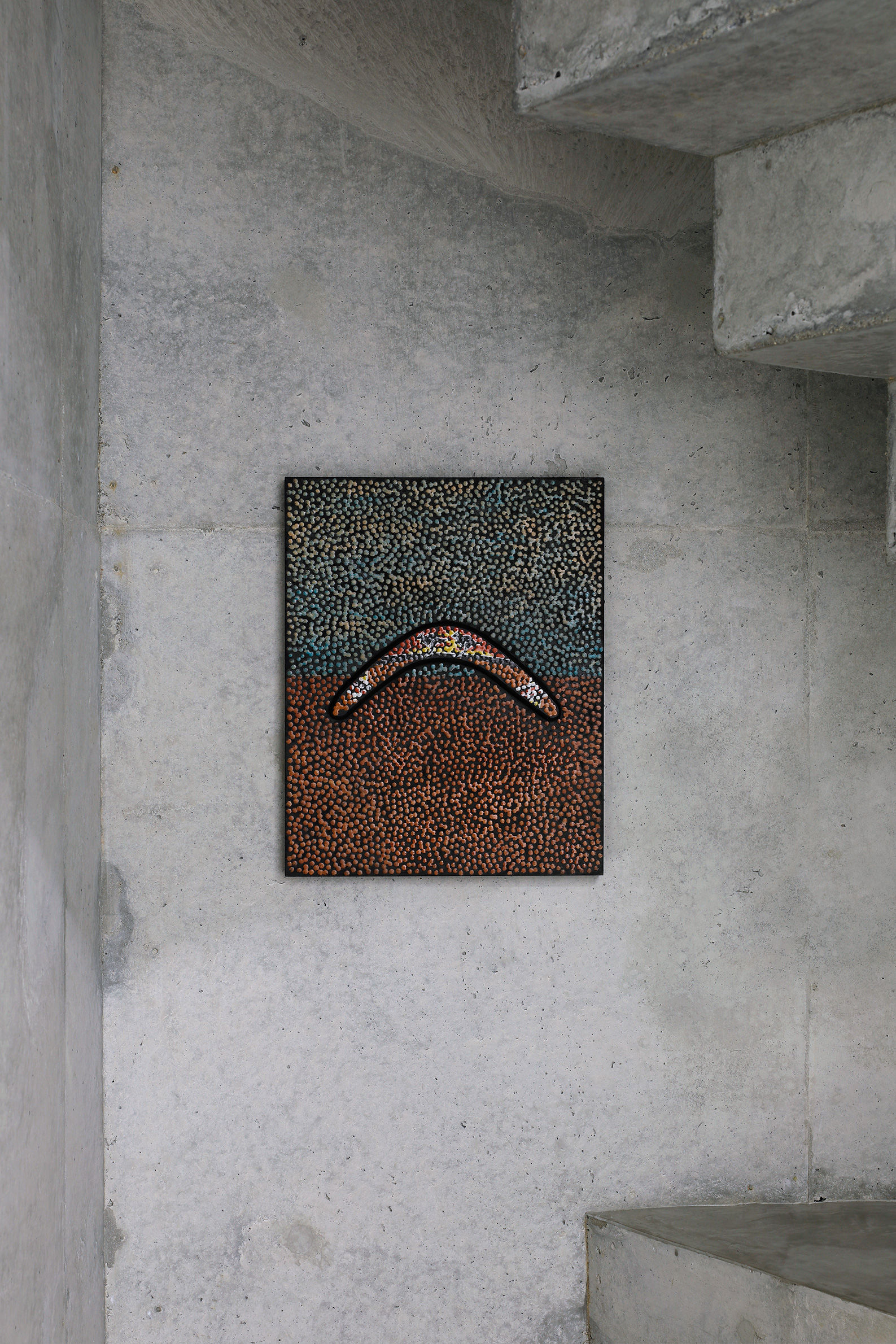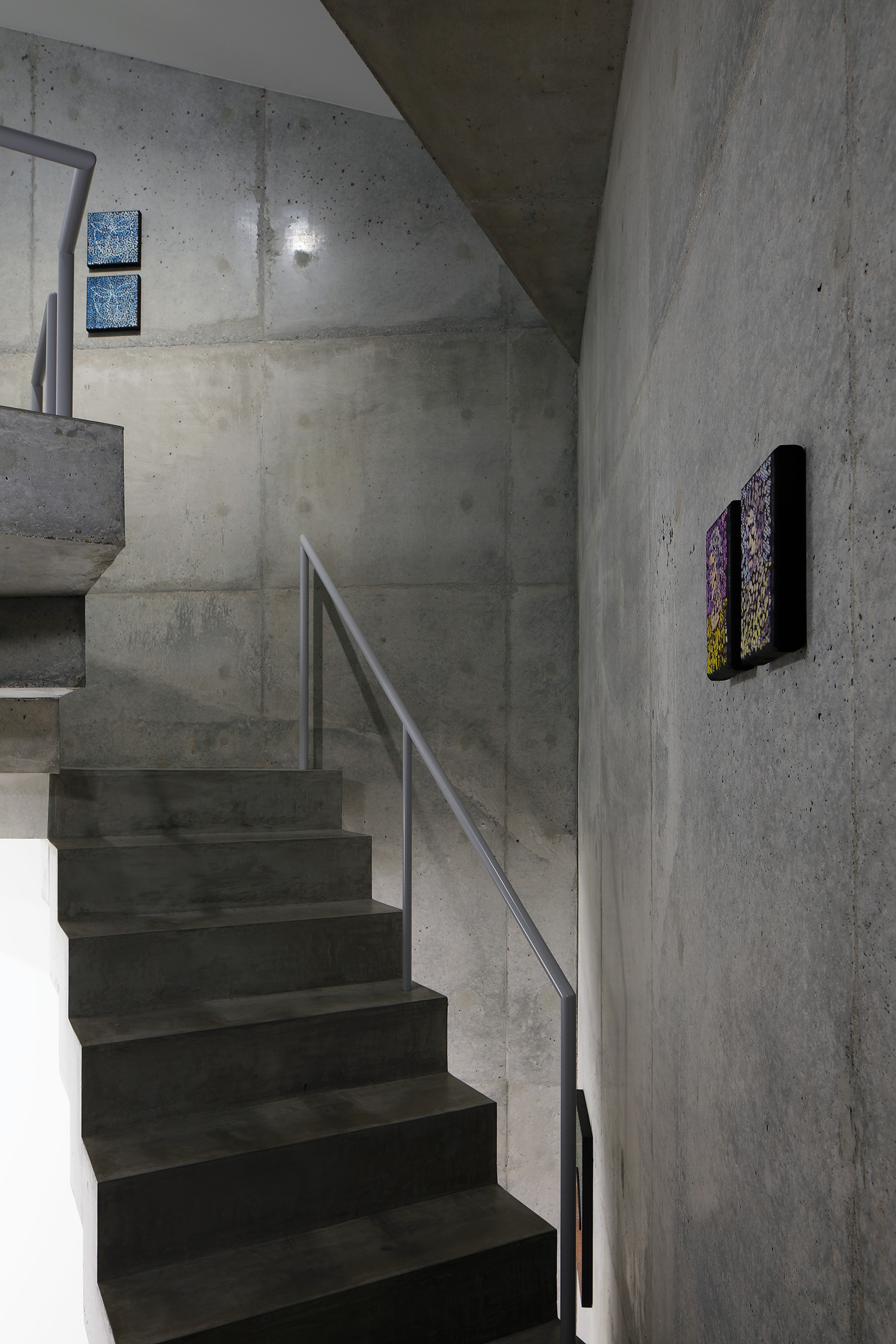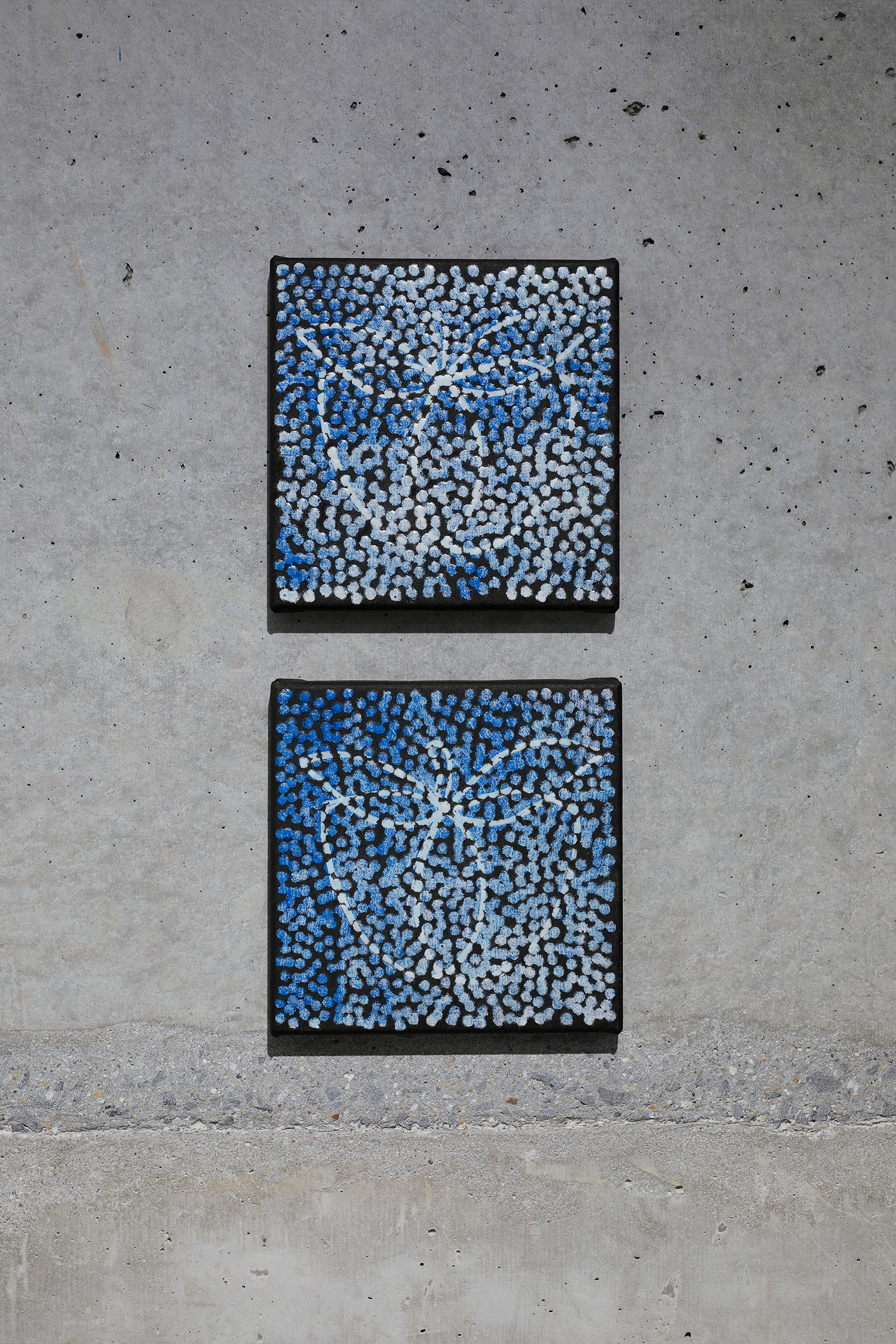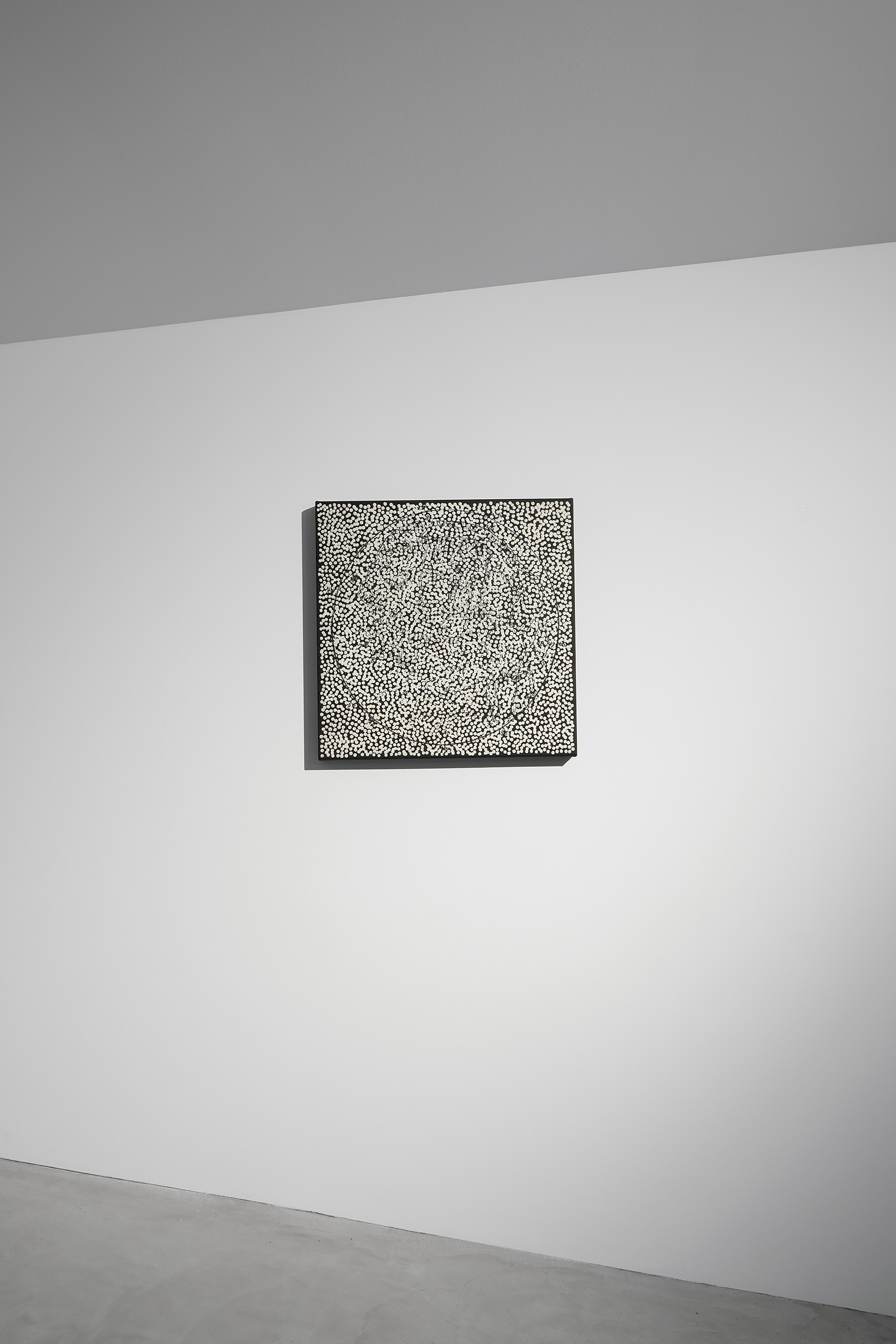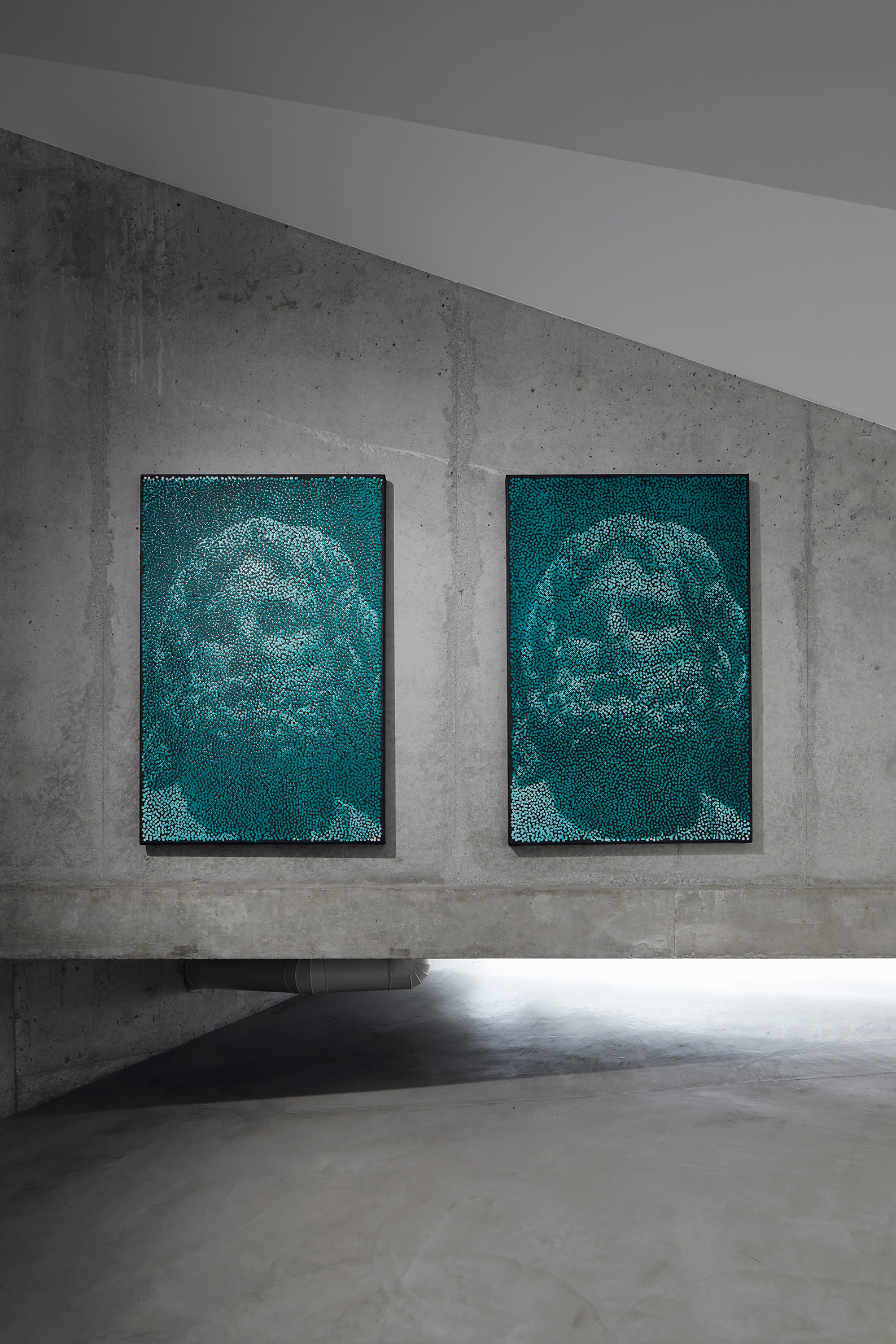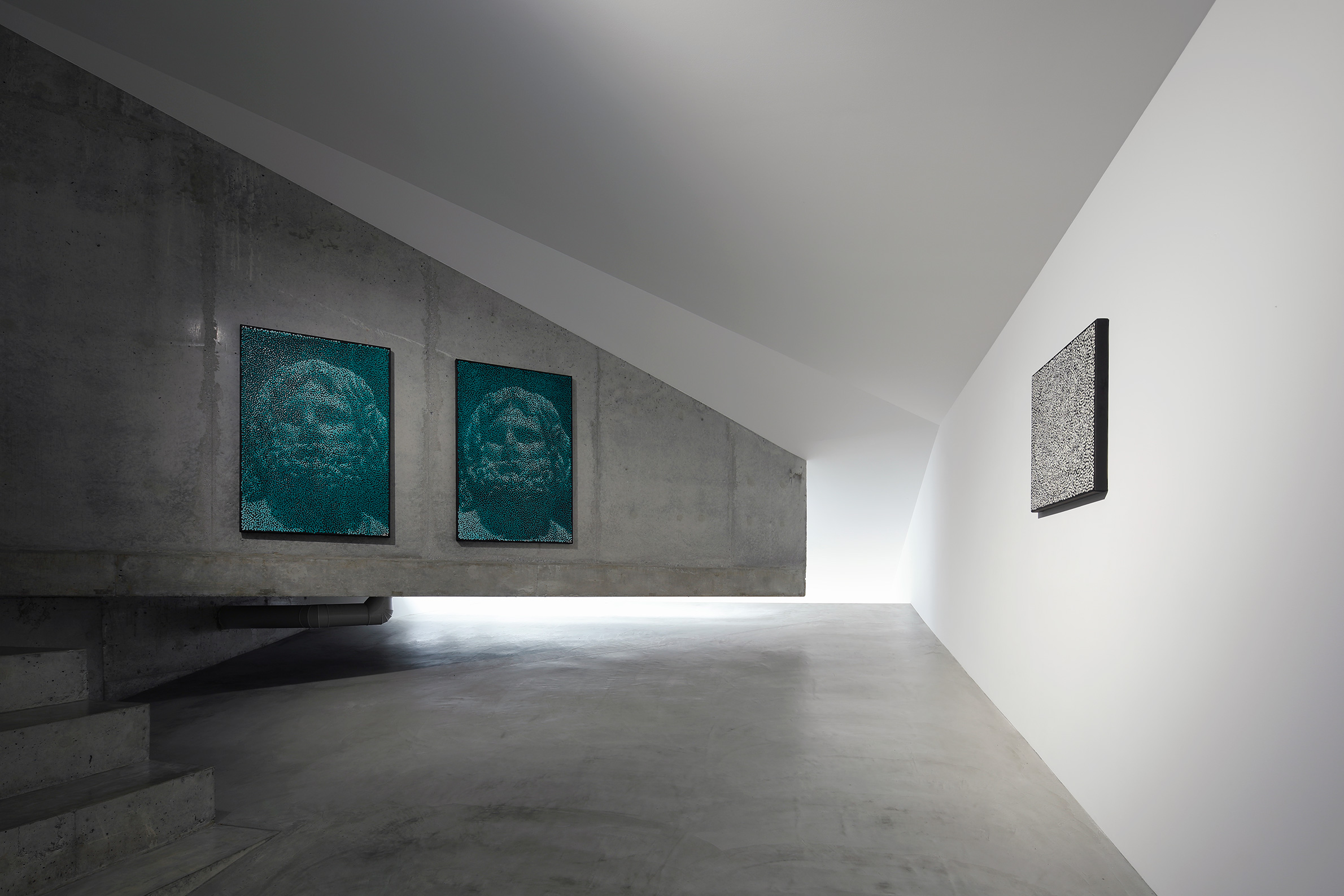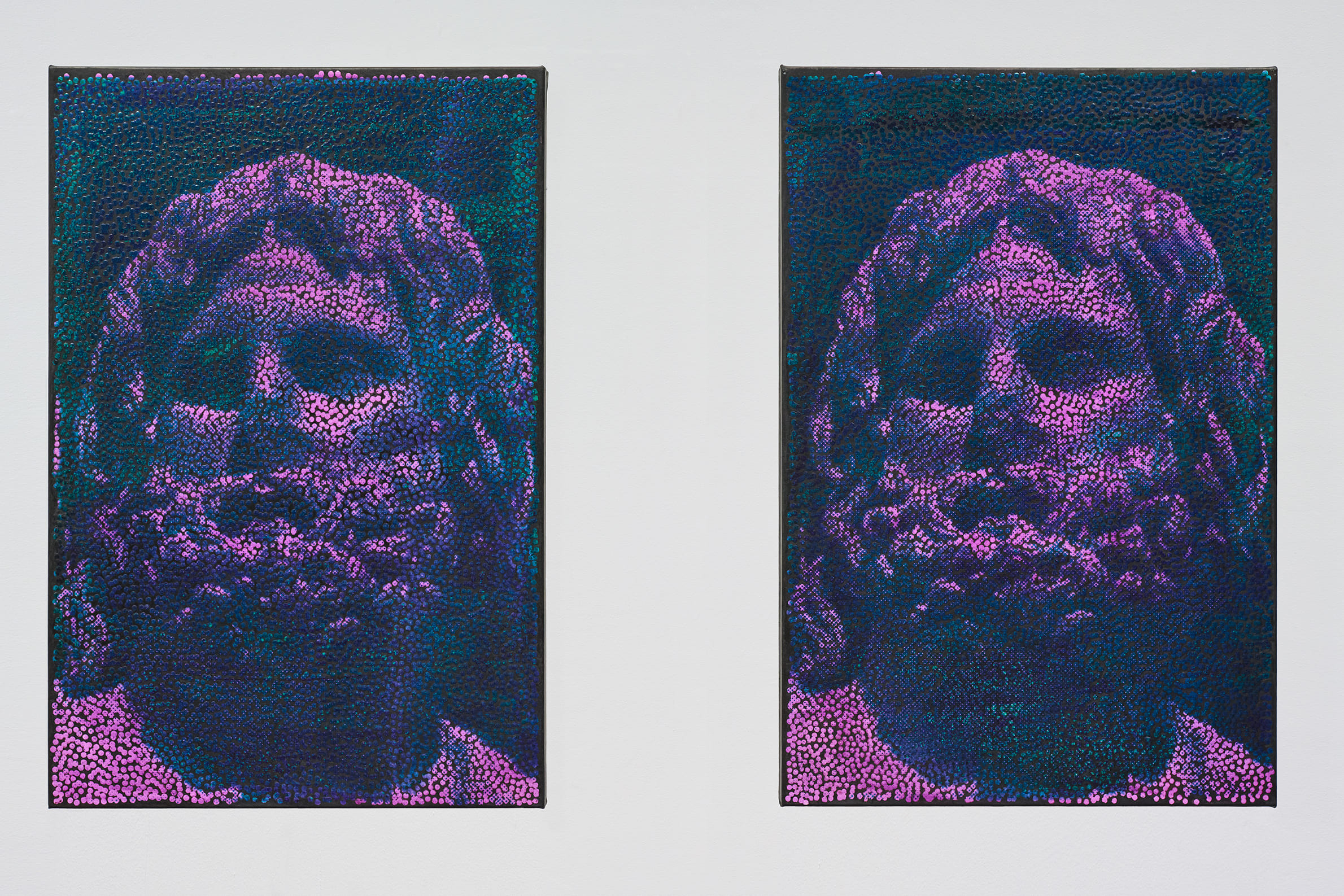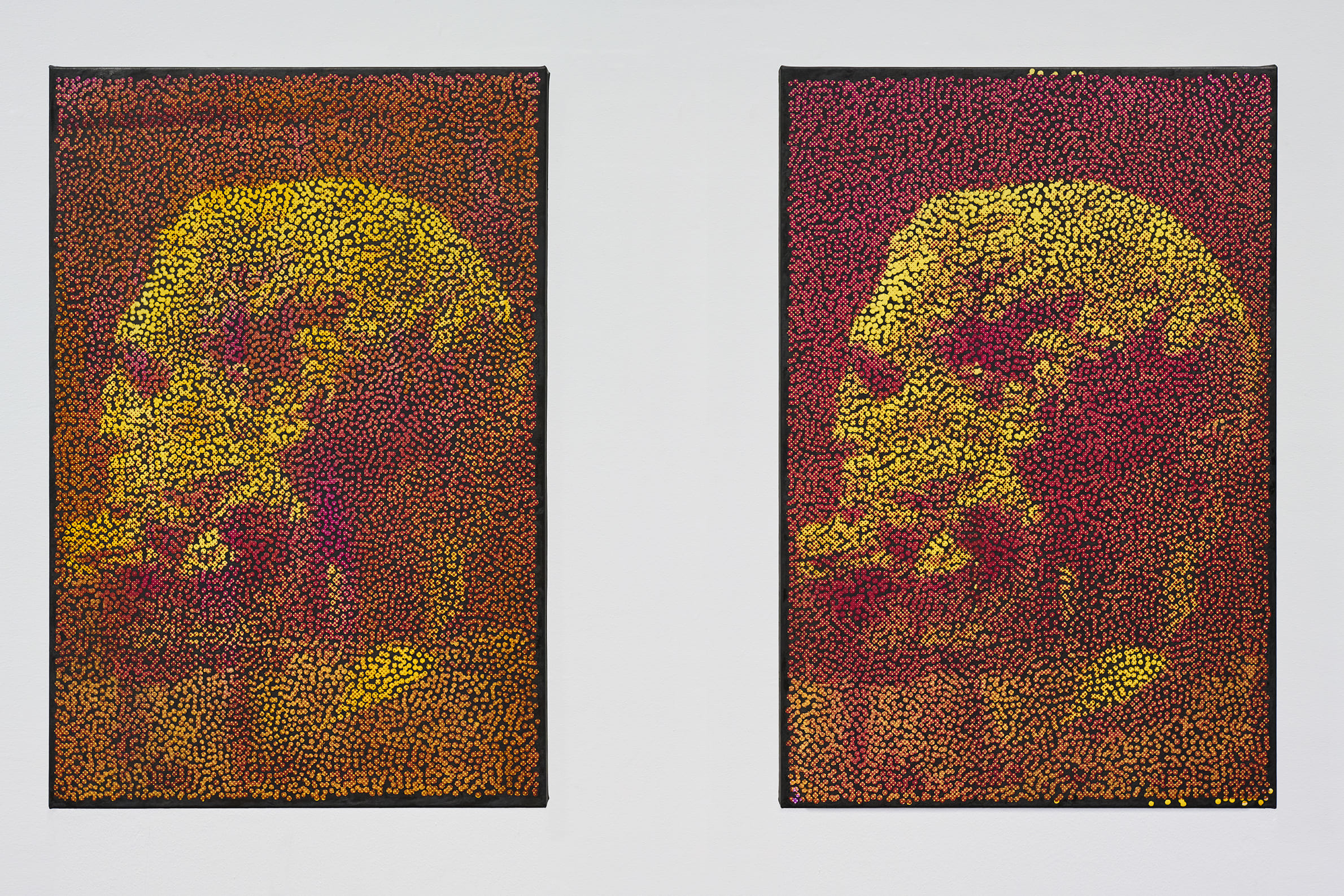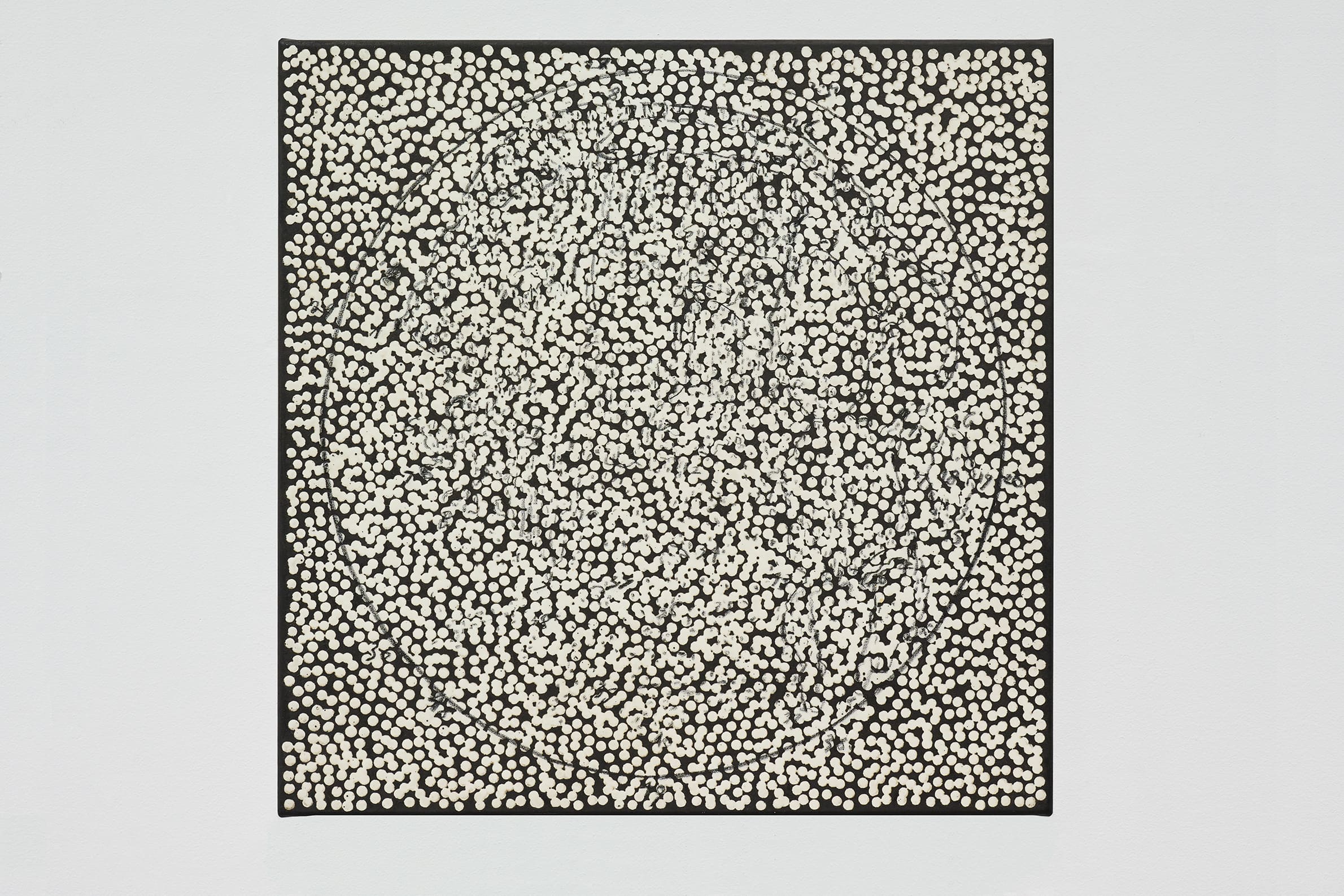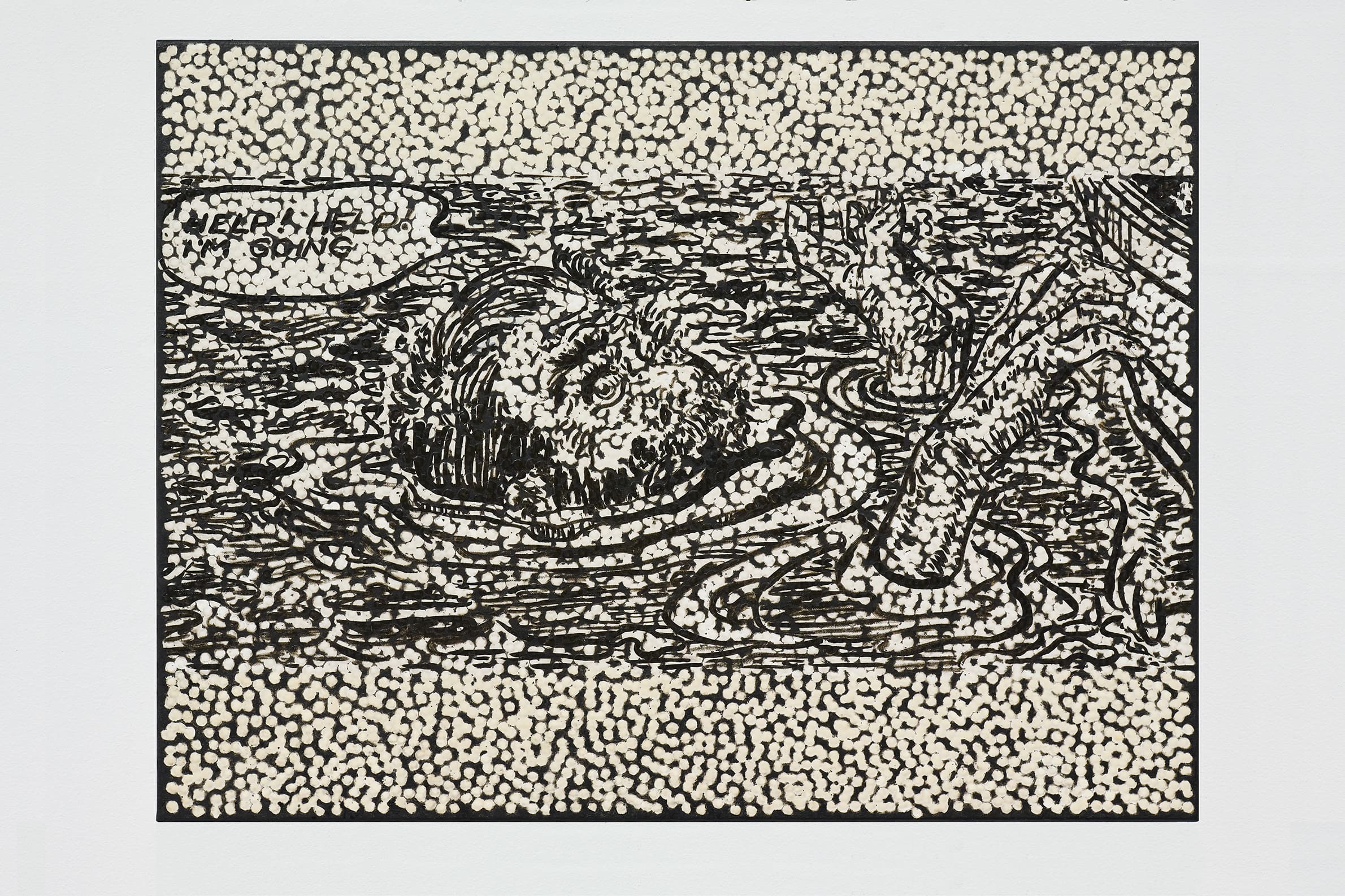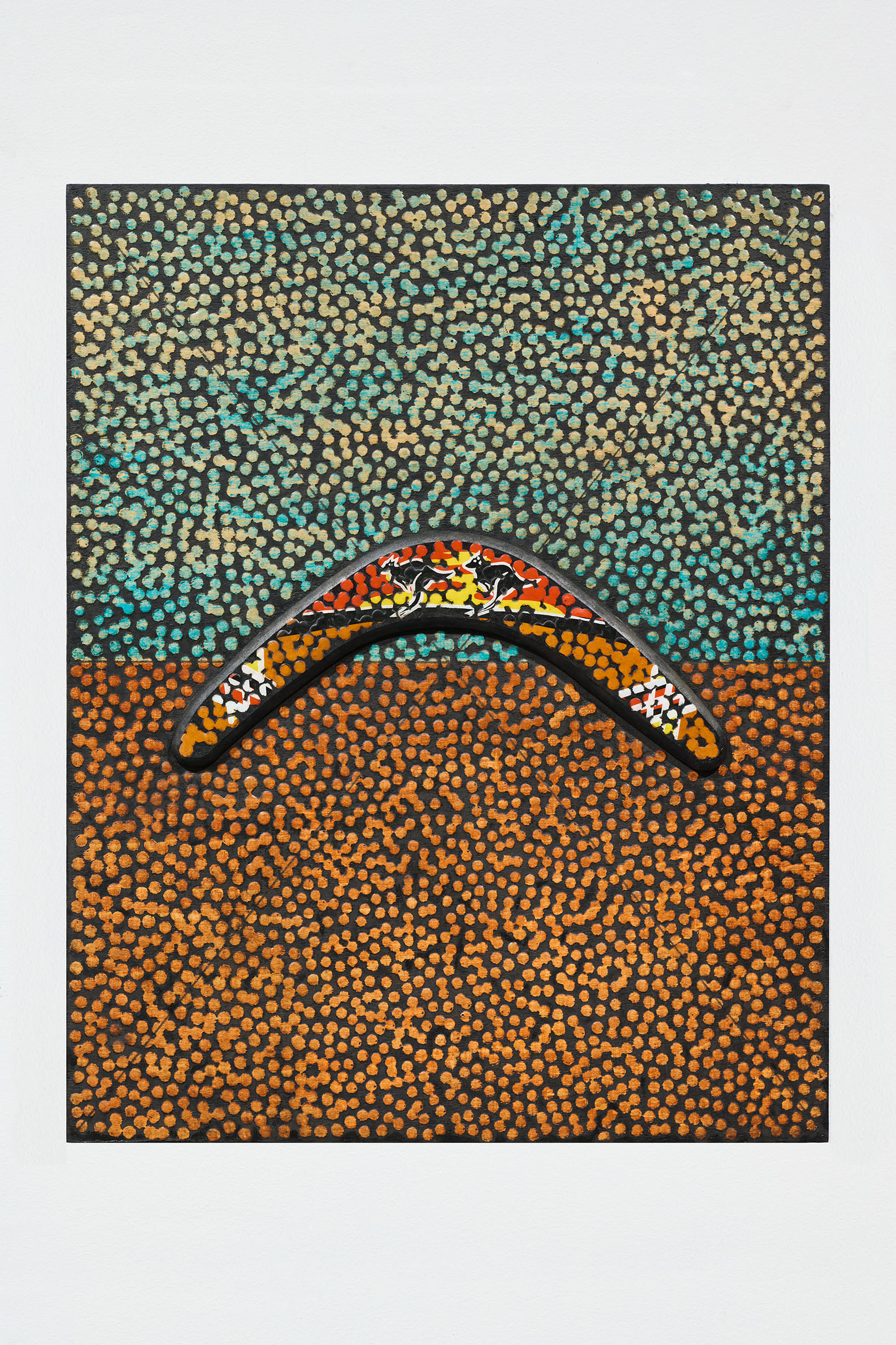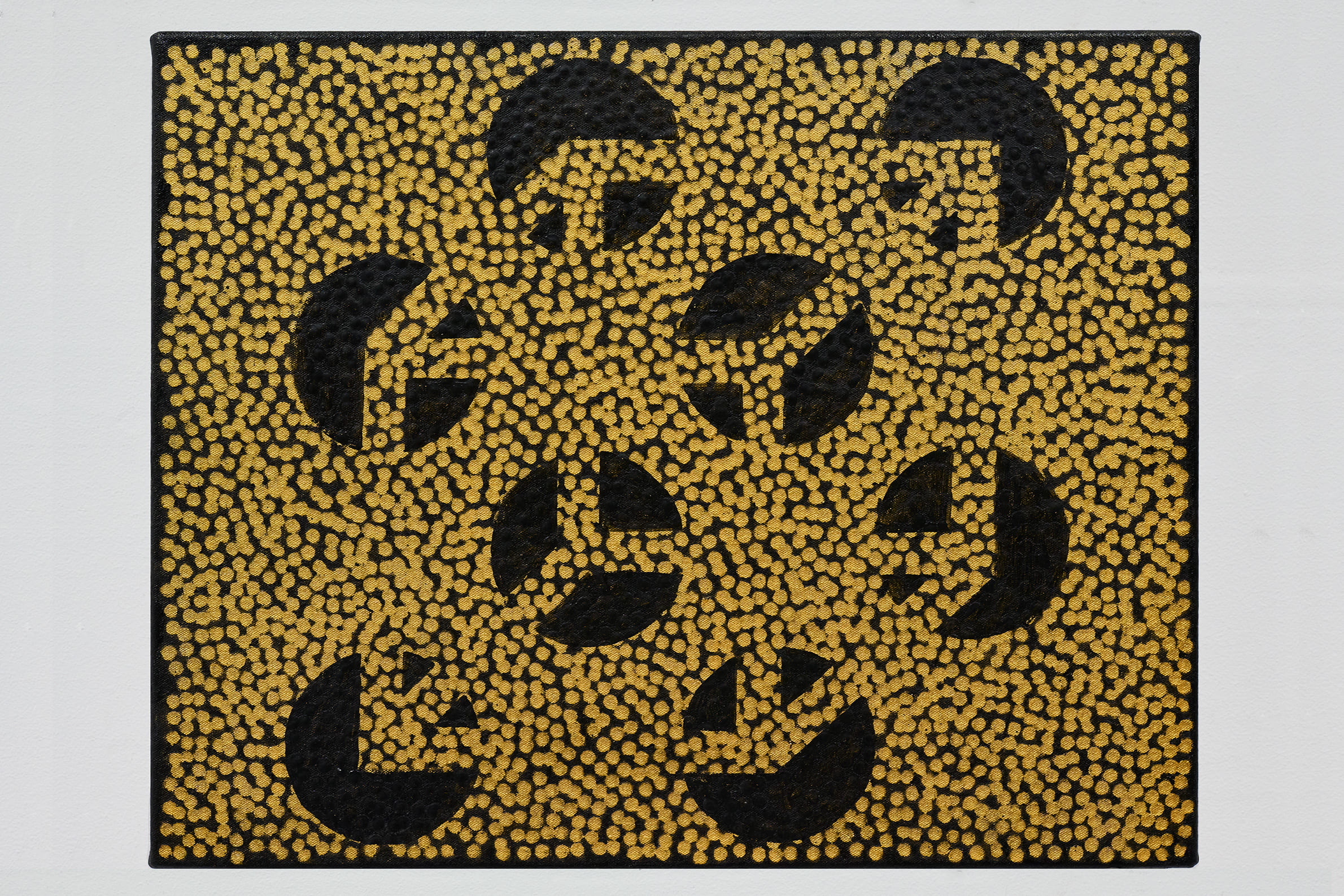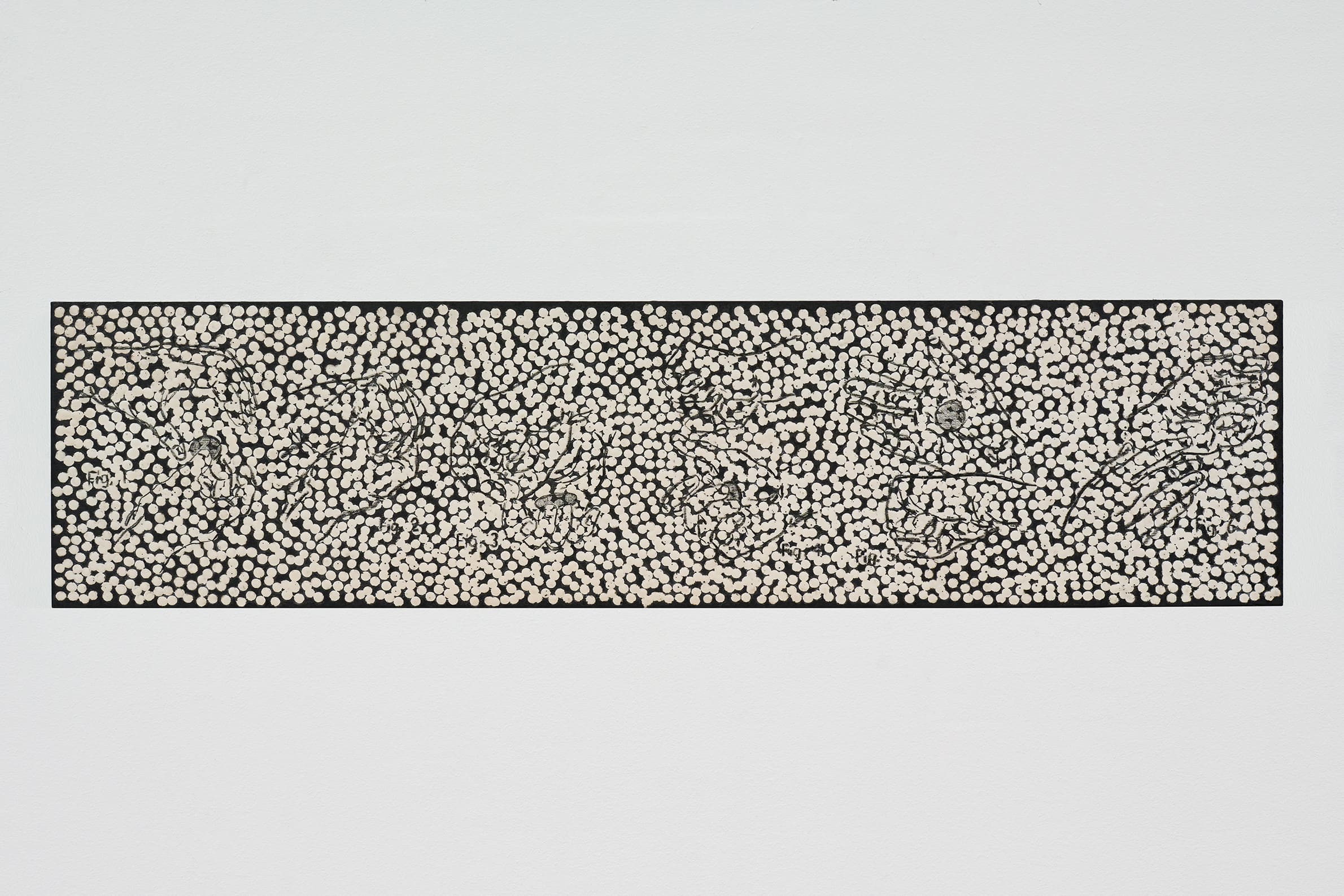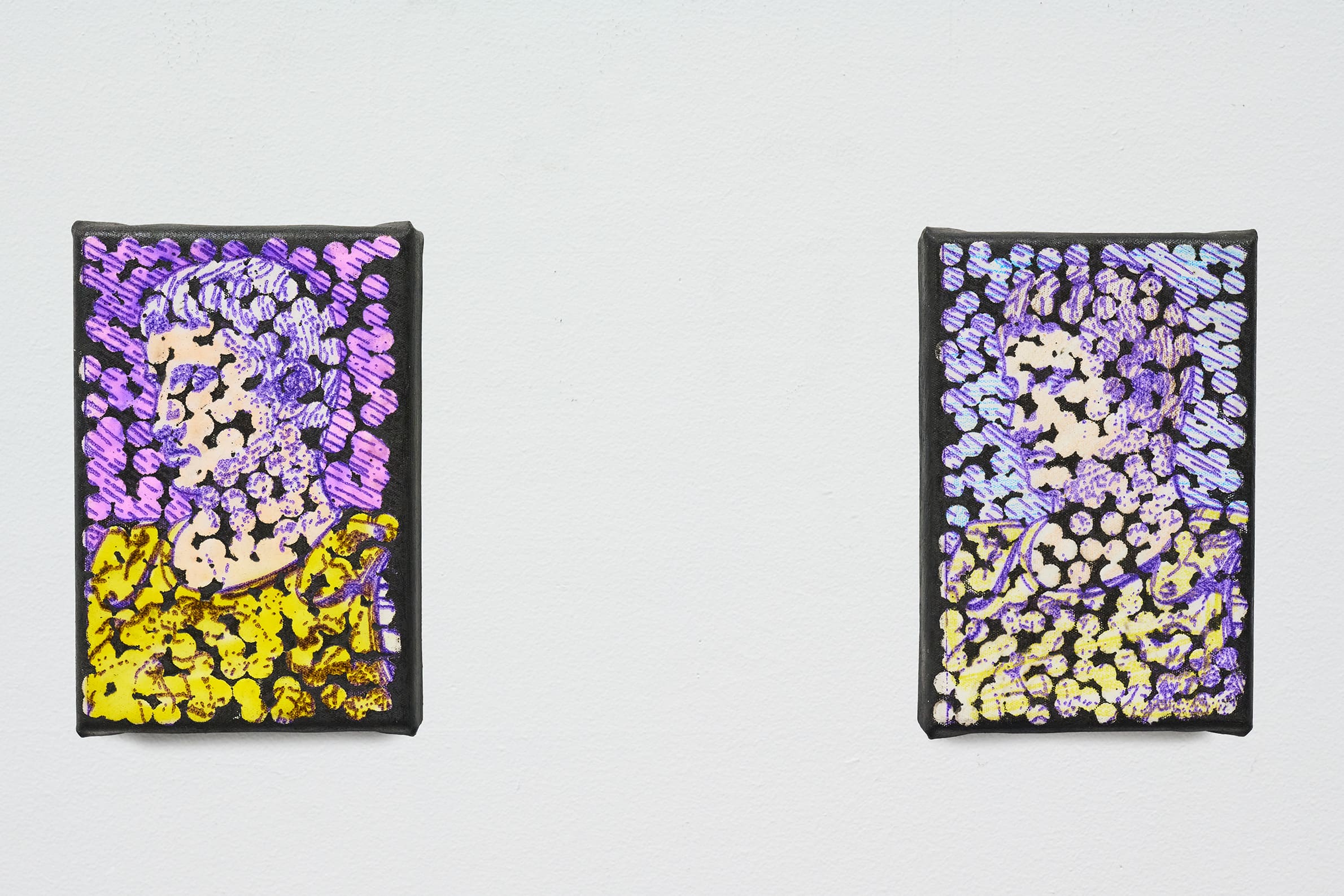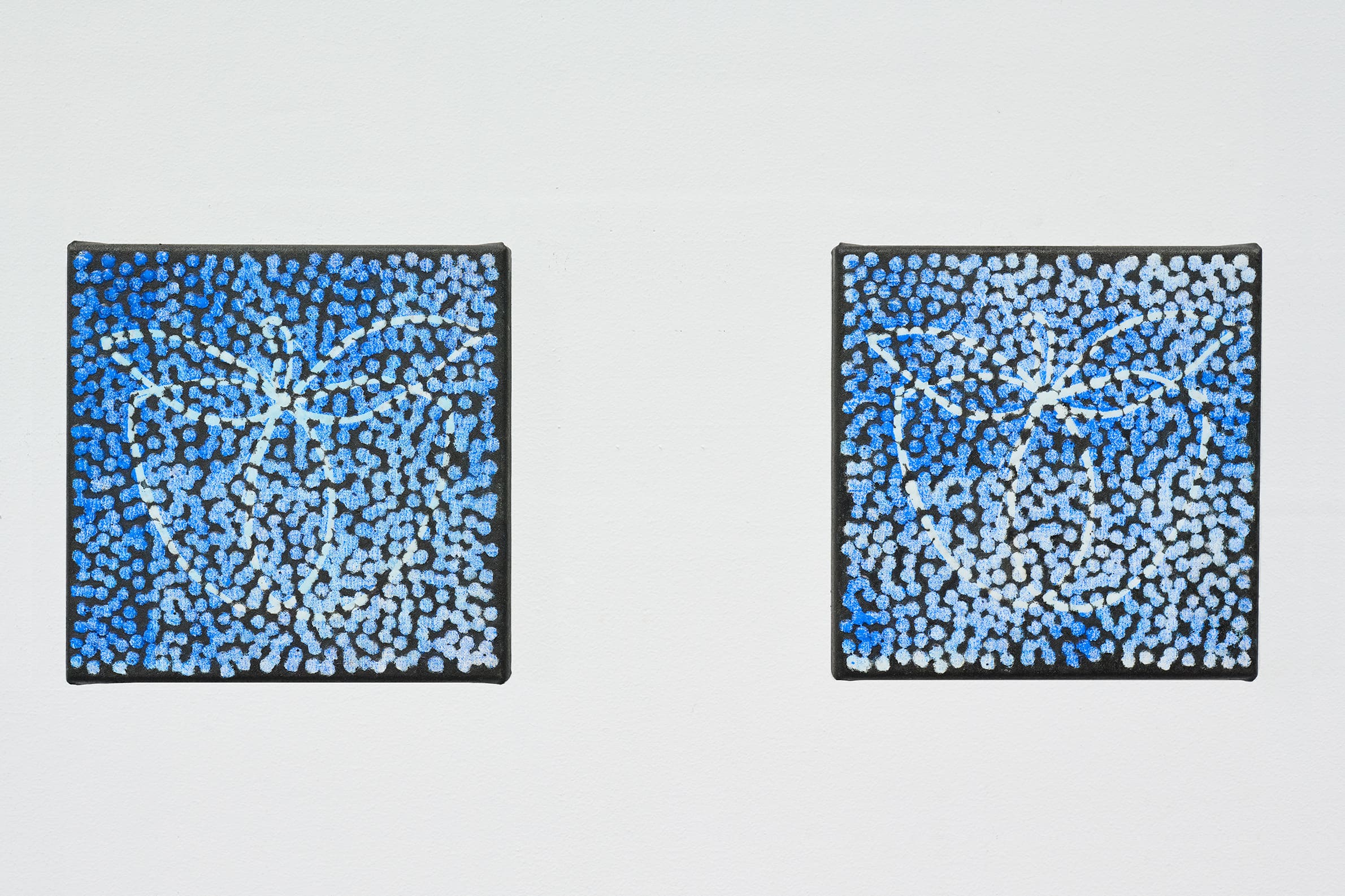Untitled (MWTES), 2025
Oil, pastel and archival glue on canvas
120 x 90 cm (47.2 x 35.4 in.)
Untitled (IDAICSWAM) (L), 2025
Oil, acrylic and archival glue on screen print on canvas
92 x 61 cm (36 x 24 in.)
Untitled (ITSIHTSWAN) (R), 2025
Oil, acrylic and archival glue on screen print on canvas
92 x 61 cm (36 x 24 in.)
Untitled (UWIISHTBP) (L), 2025
Oil, acrylic and archival glue on screen print on canvas
92 x 61 cm (36 x 24 in.)
Untitled (BTGOWIHWAN) (R), 2025
Oil, acrylic and archival glue on screen print on canvas
92 x 61 cm (36 x 24 in.)
Untitled (BTTITOYN) (L), 2025
Oil, acrylic and archival glue on screen print on canvas
92 x 61 cm (36 x 24 in.)
Untitled (WATOTNCWBATG) (R), 2025
Oil, acrylic and archival glue on screen print on canvas
92 x 61 cm (36 x 24 in.)
Untitled (IGEWTCSDSOMS), 2025
Oil, acrylic, luminescent spray paint, pencil and archival glue on canvas
50 x 50cm (19.7 x 19.7 in.)
Untitled (DWMISOAM), 2025
Oil and archival glue on canvas
45 x 60 cm (17.7 x 23.6 in.)
Untitled (WYCWTWI), 2025
Oil, pastel, pencil and archival glue on boomerang on board
50 x 40 cm (19.7 x 15.9 in.)
Untitled (OWOTOYGTSAC), 2025
Oil, acrylic and archival glue on canvas
40 x 50 cm (15.9 x 19.7 in.)
Untitled (NYSINYDL), 2025
Oil, acrylic, pencil and archival glue on board
80 x 20 cm (31.5 x 7.9 in.)
Untitled (PECAEC) (magenta background) , 2025
Oil, watercolour and archival glue on screen print on canvas
15 x 10 cm (5.9 x 3.9 in.)
Untitled (TNOYIWTFTTG) (blue background), 2025
Oil, pencil and archival glue on screen print on canvas
15 x 10 cm (5.9 x 3.9 in.)
Untitled (BTWOTWB) (top), 2025
Oil and archival glue on woodblock print on canvas
20 x 20 cm (17.9 x 17.9 in.)
Untitled (NATGIGSIB) (bottom), 2025
Oil and archival glue on woodblock print on canvas
20 x 20 cm (17.9 x 17.9)
OSCAAR MOULIGNE is pleased to announce an exhibition by Australian artist Daniel Boyd, entitled Euro Step, on view from September 6 until November 1, 2025. This marks the artist’s first solo presentation in Japan, featuring a suite of new works that continues his exploration of the multiplicity of memories, histories, and cultural identities over time.
Boyd’s practice, which spans painting, installation, and spatial interventions, seeks to challenge conceived notions—typically in relation to empirical ideologies and systems of power—as well as dominant legacies of colonialism and Eurocentric narratives. By reimagining historical archives, portraits, and landscapes, also intricately linked to his personal history and identity as a descendent of Indigenous Australians and South Sea islanders, Boyd presents a manifestation of the gaps and silences of imperial accounts while foregrounding Indigenous perspectives and lived experience.
In his paintings, Boyd creates a distinctive visual language by employing a pointillist technique that he has developed since around 2009. This process involves applying pigment or charcoal and translucent dots of archival glue to the canvas with layers or black paint or dark tones that obscure and transform his subjects. Through a process of inscription and erasure, and by partially veiling imagery with the dispersed, convex dots—which he describes as “lenses through which we can access distinct points of knowledge, experience, or perspective”— Boyd destabilizes the clarity of the image, compelling viewers to assemble the fragmented image into a coherent whole. This act of visual completion exemplifies ideas of Gestalt theories that inform the artist’s work, operating not only at the level of visual perception whereby the mind fills spaces in incomplete forms, but also as a metaphor for epistemological gaps in Australia’s colonial past. Similarly, his oscillation between foreground and background reflects the figure-ground principle (a key concept from Gestalt psychology that describes how humans visually organize information) forcing viewers to negotiate between what is obscured and what is revealed. In this way, Boyd’s works present history not as a fixed image but as a dynamic, layered, and continually shifting perceptual experience.
Several recurring motifs and metaphors weave throughout Boyd’s artistic oeuvre. In the paintings featured in the exhibition, mythical subjects, such as the classical image of the Ancient Greek god Poseidon; historical figures, like Julius Caesar; and familial and cultural symbols, such as the boomerang, are intertwined with explorations of perception, exemplified in Untitled (OWOTOYGTSAC), which depicts the Necker Cube- a classic optical illusion and well-known example in Gestalt psychology. References to water, as in the comic image of a drowning man in Untitled (DWMISOAM), and celestial bodies, such as the moon in Untitled (IGEWTCSDSOMS), are also juxtaposed with the depiction of a sports figure known for popularizing the Euro step, an offensive basketball move from which the exhibition title is derived. Boyd further conveys the dual presence of light and shadow through symbolic imagery, contrasting bright hopes and dreams with darker themes of nightmares and destructive realities.
By layering past and present narratives, Boyd constructs spaces of multiplicity and in-betweenness, where cultural memory, resilience, and resistance surface against the enduring weight of colonization. His work summons a poetic meditation on the interplay between the visible and the obscured, probing how history is remembered, interpreted, and retold in contemporary contexts. In doing so, it evokes a profound reflection on humanity and our place in the universe.
About the artist
Daniel Boyd (b. 1982, Cairns, lives and works in Sydney) is one of Australia’s most significant contemporary artists, acclaimed for his critical and transformative approach to history and representation. He studied art at the School of Art & Design at the Australian National University in Canberra and has been exhibiting internationally since 2005. His origins lie in several Australian First Nations and South Sea Islander groups such as Gudjal, Ghungalu, Wangerriburra, Wakka Wakka, Kuku Yalanji, Bundjalung, Yuggera and ni-Vanuatu.
Recent solo exhibitions include Dream Time, Marian Goodman, Paris (2024), Dreamland, Marian Goodman, New York (2024), RAINBOW SERPENT (VERSION), Martin Gropius Bau, Berlin and Institute of Modern Art, Brisbane, Australia (2023); and a major retrospective exhibition Treasure Island, Art Gallery of NSW, Sydney (2022). Recent biennales and group exhibitions include to carry, Sharjah Biennial, United Arab Emirates (2025); Bonna, Dhaka Art Summit, Dhaka, Bangladesh (2023); Kathmandu Triennale 2077, Kathmandu, Nepal, curated by Cosmin Costinas (2022); UN/LEARNING AUSTRALIA, Seoul Museum of Art, Seoul (2021-22); Divided Worlds, Adelaide Biennial of Australian Art, Art Gallery of South Australia (2018); Mondialité, Boghossian Foundation, Villa Empain, Brussels, curated by Hans Ulrich Obrist & Asad Raza (2017); The future is already here – it’s just not evenly distributed, 20th Biennale of Sydney, curated by Stephanie Rosenthal (2016) and All the World’s Futures, the 56th Venice Biennale (2015), curated by Okwui Enwezor. Boyd was the recipient of the prestigious Bulgari Art Award (2014). His work is held in major collections worldwide, including the Tate, the National Gallery of Australia, and the Art Gallery of New South Wales.
OSCAAR MOULIGNEは、オーストラリア人アーティスト、ダニエル・ボイド(Daniel Boyd)による個展 Euro Step を、2025年9月6日から11月1日まで開催いたします。本展は、日本におけるボイドの初めての個展となり、記憶、歴史、そして文化的アイデンティティの多層性を探究し続ける新作のペインティングを発表いたします。
ボイドは、絵画やインスタレーションを通して経験的イデオロギーや権力のシステム、さらには植民地主義やヨーロッパ中心主義的な言説の遺産を問い直す作品を制作しています。歴史的アーカイブ、肖像画、風景を再構築しつつ、それらを自身の出自—オーストラリア先住民とサウスシー諸島民の子孫としての個人的な歴史やアイデンティティ—と緊密に結びつけることで、帝国的記録の空白や沈黙を顕在化させ、先住民の視点や生の経験を前景化します。
ペインティングでは、2009年頃から発展させてきた点描的な技法によって独自の視覚言語が構築されています。この技法は、顔料や木炭に加え、アーカイヴ用接着剤を半透明の点として画面に施し、さらに黒や濃い色彩の層を重ねることで主題を覆い、変容させるものです。刻印と消去のプロセスを通じ、また散在する凸状の点によってイメージを部分的に覆い隠すことにより、ボイドは画面の明晰さを不安定化させます。ボイドが「知識や経験、視点の異なる点にアクセスするためのレンズ」と表現するこれらの点は、観者に断片化された像を統合し、全体像を構築することを促します。この視覚的補完の行為は、ゲシュタルト心理学における「不完全な形態を心が補う」原理を体現すると同時に、オーストラリア植民地史における認識の空白の隠喩ともなります。さらに、前景と背景の間を揺れ動く構図は、ゲシュタルト心理学における「図と地」の原理を想起させ、観者を「見えるもの」と「隠されたもの」とのあいだで交渉させます。このようにして、ボイドの作品は歴史を固定されたイメージとしてではなく、動的で多層的、かつ絶えず変化し続ける知覚体験として提示します。
本展に出品される作品にも、ボイドの作品制作に通底するモチーフやメタファーが繰り返し登場します。ギリシャ神話の海神ポセイドンの古典的なイメージ、ユリウス・カエサルの肖像といった歴史的人物、ブーメランのような文化的象徴は、知覚と錯視の探究と結びつけられています。たとえば《Untitled (OWOTOYGTSAC)》では、古典的な視覚的錯覚でありゲシュタルト心理学の代表例であるネッカーの立方体が描かれています。さらに、《Untitled (DWMISOAM)》に見られる溺れる人のイメージや、《Untitled (IGEWTCSDSOMS)》に描かれる月といった水や天体のモチーフは、ユーロステップというバスケットボールの攻撃的フットワークを広めた著名なスポーツ選手のイメージと並置されています。本展タイトルもこの動きに由来しています。ボイドはまた、象徴的イメージを通して光と影の二重性を表現し、希望や夢といった明るいイメージを、悪夢、支配、破壊的な現実といった暗いテーマと対比させます。
過去と現在の物語を重ね合わせることで、ボイドは多層性や「間(あいだ)」の空間を構築し、そこに文化的記憶、レジリエンス、抵抗が植民地主義の重圧に抗して立ち現れます。ボイドの作品は「見えるもの」と「隠されたもの」との相互作用を詩的に瞑想し、歴史がいかに記憶され、解釈され、語り直されるのかを問いかけます。そして最終的に、人間性や私たちの宇宙における位置について深い省察を促します。
作家について
ダニエル・ボイド(Daniel Boyd, 1982年ケアンズ生まれ、シドニー在住)は、オーストラリアを代表する現代美術家のひとりであり、歴史や表象に対する批判的かつ変革的なアプローチで高く評価されています。キャンベラのオーストラリア国立大学美術デザイン学部で学び、2005年より国際的に活動を展開しています。彼の出自は、Gudjal、Ghungalu、Wangerriburra、Wakka Wakka、Kuku Yalanji、Bundjalung、Yuggera、そして ni-Vanuatu など、複数のオーストラリア先住民族およびサウスシー諸島民に由来しています。
近年の個展には、《Dream Time》(マリアン・グッドマン・ギャラリー、パリ、2024年)、《Dreamland》(マリアン・グッドマン・ギャラリー、ニューヨーク、2024年)、《RAINBOW SERPENT (VERSION)》(マルティン・グロピウス・バウ、ベルリン/インスティテュート・オブ・モダン・アート、ブリスベン、2023年)、回顧展《Treasure Island》(ニュー・サウス・ウェールズ州立美術館、シドニー、2022年)などがあります。近年の国際展やグループ展には、《to carry》(シャルジャ・ビエンナーレ、UAE、2025年)、《Bonna》(ダッカ・アート・サミット、バングラデシュ、2023年)、《カトマンズ・トリエンナーレ2077》(ネパール、2022年)、《UN/LEARNING AUSTRALIA》(ソウル市立美術館、韓国、2021–22年)、《Divided Worlds》(アデレード・ビエンナーレ、南オーストラリア州立美術館、2018年)、《Mondialité》(ボゴシアン財団ヴィラ・アンパン、ブリュッセル、2017年)、《20th Biennale of Sydney》(シドニー・ビエンナーレ、2016年)、《56th Venice Biennale》(ヴェネツィア・ビエンナーレ、2015年)などがあります。2014年には権威あるブルガリ・アート・アワードを受賞。彼の作品は、テート、オーストラリア国立美術館、ニュー・サウス・ウェールズ州立美術館をはじめ、世界各地の主要コレクションに収蔵されています。

